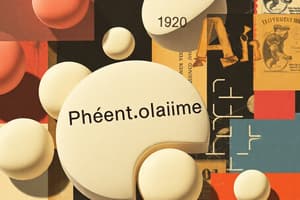Podcast
Questions and Answers
What is the primary function of adrenergic antagonist drugs?
What is the primary function of adrenergic antagonist drugs?
- To prevent or reverse the effects of norepinephrine or epinephrine. (correct)
- To promote the synthesis of norepinephrine within the neuron.
- To stimulate the actions of endogenously released epinephrine.
- To enhance the release of norepinephrine from adrenergic neurons.
Which of the following is a primary target for adrenergic antagonist drugs?
Which of the following is a primary target for adrenergic antagonist drugs?
- Serotonergic receptors.
- Cholinergic receptors.
- Dopaminergic receptors.
- Adrenoceptors. (correct)
How do adrenergic antagonists typically interact with adrenoceptors?
How do adrenergic antagonists typically interact with adrenoceptors?
- They prevent the agonist from binding to the receptor. (correct)
- They promote the synthesis of the agonists within the neuron.
- They increase the affinity of the receptors to agonists.
- They act as full agonists, eliciting maximal response.
What is the main source of the agonists that adrenergic antagonists act upon?
What is the main source of the agonists that adrenergic antagonists act upon?
Besides the primary endogenous agonists, what other type of substances can adrenergic antagonists counteract?
Besides the primary endogenous agonists, what other type of substances can adrenergic antagonists counteract?
Which of the following is a therapeutic use of an $\alpha_1$-selective antagonist?
Which of the following is a therapeutic use of an $\alpha_1$-selective antagonist?
A patient taking a monoamine oxidase inhibitor ingests tyramine-containing foods and experiences a hypertensive crisis. Which medication is most likely to treat this condition among the medications detailed in the text?
A patient taking a monoamine oxidase inhibitor ingests tyramine-containing foods and experiences a hypertensive crisis. Which medication is most likely to treat this condition among the medications detailed in the text?
What is the primary mechanism by which prazosin lowers blood pressure?
What is the primary mechanism by which prazosin lowers blood pressure?
Which of the following is a common adverse effect associated with taking prazosin?
Which of the following is a common adverse effect associated with taking prazosin?
Which adrenoceptor subtype is primarily responsible for smooth muscle contraction in the prostate?
Which adrenoceptor subtype is primarily responsible for smooth muscle contraction in the prostate?
Which of the following is a contraindication for the use of $\alpha_1$-selective antagonists mentioned in the text?
Which of the following is a contraindication for the use of $\alpha_1$-selective antagonists mentioned in the text?
What is the recommended approach to minimize the first-dose effect of orthostatic hypotension with prazosin?
What is the recommended approach to minimize the first-dose effect of orthostatic hypotension with prazosin?
Which of the following is an off-label therapeutic use of prazosin?
Which of the following is an off-label therapeutic use of prazosin?
What is the primary distinction in categorizing α-blockers?
What is the primary distinction in categorizing α-blockers?
Which of the following is the longest-acting alpha-1 adrenergic antagonist?
Which of the following is the longest-acting alpha-1 adrenergic antagonist?
What is a characteristic of irreversible α-blockers?
What is a characteristic of irreversible α-blockers?
What is the main effect of blocking α1-adrenoceptors on the cardiovascular system?
What is the main effect of blocking α1-adrenoceptors on the cardiovascular system?
A patient is starting on terazosin therapy. Which of the following instructions is most important to provide to the patient regarding medication administration?
A patient is starting on terazosin therapy. Which of the following instructions is most important to provide to the patient regarding medication administration?
Which of the following alpha-adrenergic antagonists is primarily used for benign prostatic hyperplasia and is known to have the worst incidence of intraoperative floppy iris syndrome?
Which of the following alpha-adrenergic antagonists is primarily used for benign prostatic hyperplasia and is known to have the worst incidence of intraoperative floppy iris syndrome?
Why does the lowering of blood pressure via α1-blockade often induce reflex tachycardia?
Why does the lowering of blood pressure via α1-blockade often induce reflex tachycardia?
Which of the following describes a key difference in mechanism of action between tamsulosin and terazosin?
Which of the following describes a key difference in mechanism of action between tamsulosin and terazosin?
What is the primary mechanism by which α1-adrenergic receptor blockade reduces blood pressure?
What is the primary mechanism by which α1-adrenergic receptor blockade reduces blood pressure?
What is a significant difference between reversible and irreversible α-blockers?
What is a significant difference between reversible and irreversible α-blockers?
Which of the following is an adverse effect specifically associated with doxazosin, but not the other listed alpha-1 blockers?
Which of the following is an adverse effect specifically associated with doxazosin, but not the other listed alpha-1 blockers?
A patient is experiencing retrograde ejaculation while taking an alpha-adrenergic antagonist, which medication is most likely causing this side effect?
A patient is experiencing retrograde ejaculation while taking an alpha-adrenergic antagonist, which medication is most likely causing this side effect?
What is the clinical utility of selective α2-adrenergic blockers?
What is the clinical utility of selective α2-adrenergic blockers?
Where does the normal sympathetic control of vasculature largely occur?
Where does the normal sympathetic control of vasculature largely occur?
Which of the following statements best explains the pharmacological effect of alpha-1 adrenergic antagonists on blood pressure?
Which of the following statements best explains the pharmacological effect of alpha-1 adrenergic antagonists on blood pressure?
Which of the following medications increases central sympathetic activity through its mechanism of action?
Which of the following medications increases central sympathetic activity through its mechanism of action?
Which of the following best describes the mechanism of action of phenoxybenzamine?
Which of the following best describes the mechanism of action of phenoxybenzamine?
What is the primary reason phenoxybenzamine is no longer a first-line treatment for chronic hypertension?
What is the primary reason phenoxybenzamine is no longer a first-line treatment for chronic hypertension?
A patient is experiencing reflex tachycardia after being administered phenoxybenzamine. Which of the following medications could be used to manage this side effect?
A patient is experiencing reflex tachycardia after being administered phenoxybenzamine. Which of the following medications could be used to manage this side effect?
Which of the following best describes the mechanism of action of phentolamine?
Which of the following best describes the mechanism of action of phentolamine?
Which of the following is a therapeutic use for phentolamine that is NOT listed for phenoxybenzamine?
Which of the following is a therapeutic use for phentolamine that is NOT listed for phenoxybenzamine?
A patient with pheochromocytoma is prescribed phenoxybenzamine. Why is this drug considered a suitable initial choice?
A patient with pheochromocytoma is prescribed phenoxybenzamine. Why is this drug considered a suitable initial choice?
A patient taking phenoxybenzamine reports difficulty with ejaculation. What is the best explanation for this effect?
A patient taking phenoxybenzamine reports difficulty with ejaculation. What is the best explanation for this effect?
Which of the following adverse effects is MOST likely to occur with both phenoxybenzamine and phentolamine treatment?
Which of the following adverse effects is MOST likely to occur with both phenoxybenzamine and phentolamine treatment?
Flashcards
Adrenergic Antagonists
Adrenergic Antagonists
Drugs that block the effects of norepinephrine and epinephrine by binding to adrenergic receptors.
How do adrenergic antagonists work?
How do adrenergic antagonists work?
These drugs interact with either alpha (α) or beta (β) adrenoceptors to prevent or reverse the effects of adrenaline or noradrenaline.
What do adrenergic antagonists do?
What do adrenergic antagonists do?
These drugs prevent or reverse the actions of naturally released norepinephrine or epinephrine or even synthetically made adrenaline-like drugs.
What are some clinical uses of Adrenergic Antagonists?
What are some clinical uses of Adrenergic Antagonists?
Signup and view all the flashcards
Why do we use adrenergic antagonists?
Why do we use adrenergic antagonists?
Signup and view all the flashcards
α-blockers
α-blockers
Signup and view all the flashcards
Nonselective α-blockers
Nonselective α-blockers
Signup and view all the flashcards
Selective α-blockers
Selective α-blockers
Signup and view all the flashcards
Reversible α-blockers
Reversible α-blockers
Signup and view all the flashcards
Irreversible α-blockers
Irreversible α-blockers
Signup and view all the flashcards
α1-adrenoceptor blockade
α1-adrenoceptor blockade
Signup and view all the flashcards
Reflex tachycardia
Reflex tachycardia
Signup and view all the flashcards
Selective α2-adrenergic blockers
Selective α2-adrenergic blockers
Signup and view all the flashcards
Hypertensive Crisis
Hypertensive Crisis
Signup and view all the flashcards
Alpha-Blocker Antagonist
Alpha-Blocker Antagonist
Signup and view all the flashcards
Preventing Dermal Necrosis
Preventing Dermal Necrosis
Signup and view all the flashcards
Orthostatic Hypotension
Orthostatic Hypotension
Signup and view all the flashcards
Alpha1A Receptor
Alpha1A Receptor
Signup and view all the flashcards
Alpha1B Receptor
Alpha1B Receptor
Signup and view all the flashcards
Alpha1D Receptor
Alpha1D Receptor
Signup and view all the flashcards
How do alpha-blockers help with BPH?
How do alpha-blockers help with BPH?
Signup and view all the flashcards
What is the main action of Phenoxybenzamine?
What is the main action of Phenoxybenzamine?
Signup and view all the flashcards
What kind of duration effect does Phenoxybenzamine have?
What kind of duration effect does Phenoxybenzamine have?
Signup and view all the flashcards
Is the blocking effect of Phenoxybenzamine reversible or not?
Is the blocking effect of Phenoxybenzamine reversible or not?
Signup and view all the flashcards
Which type of alpha receptor does Phenoxybenzamine predominantly target?
Which type of alpha receptor does Phenoxybenzamine predominantly target?
Signup and view all the flashcards
What is the main action of Phentolamine?
What is the main action of Phentolamine?
Signup and view all the flashcards
Is the blocking effect of Phentolamine reversible or not?
Is the blocking effect of Phentolamine reversible or not?
Signup and view all the flashcards
How are Phenoxybenzamine and Phentolamine used in treating pheochromocytoma?
How are Phenoxybenzamine and Phentolamine used in treating pheochromocytoma?
Signup and view all the flashcards
In what other situation might Phentolamine be used?
In what other situation might Phentolamine be used?
Signup and view all the flashcards
What does the term α1A selectivity refer to?
What does the term α1A selectivity refer to?
Signup and view all the flashcards
What is Intraoperative Floppy Iris Syndrome (IFIS)?
What is Intraoperative Floppy Iris Syndrome (IFIS)?
Signup and view all the flashcards
How can α1-blockers affect cataract surgery?
How can α1-blockers affect cataract surgery?
Signup and view all the flashcards
What are non-selective α-blockers?
What are non-selective α-blockers?
Signup and view all the flashcards
What is yohimbine and what are its actions?
What is yohimbine and what are its actions?
Signup and view all the flashcards
What is orthostatic hypotension?
What is orthostatic hypotension?
Signup and view all the flashcards
What are the main effects of α1-blockers on blood pressure?
What are the main effects of α1-blockers on blood pressure?
Signup and view all the flashcards
What is angioedema?
What is angioedema?
Signup and view all the flashcards
Study Notes
Adrenergic Antagonists Lecture - 16
- Mayur S. Parmar, Ph.D., Assistant Professor of Pharmacology, Department of Foundational Sciences, Dr. Kiran C. Patel College of Osteopathic Medicine, Nova Southeastern University
- Lecture focused on Adrenergic Antagonists
Learning Objectives
- Identify specific alpha-adrenergic antagonists and the receptor subtype they act upon.
- Discuss the mechanism of action of alpha-adrenergic antagonists.
- Discuss the pharmacological effects and clinical efficacy of alpha-adrenergic antagonists based on receptor interactions.
- Discuss the therapeutic uses and adverse effects of alpha-adrenergic antagonists.
- Discuss potential contraindications and drug interactions for selected alpha-adrenergic antagonists and the reasons.
Adrenergic Antagonists
- Drugs interacting with alpha or beta adrenoceptors, preventing or reversing norepinephrine/epinephrine or sympathomimetic agent actions.
- Alpha blockers: Nonselective (alpha-1 and alpha-2) or Selective (alpha-1 or alpha-2).
- Beta blockers: Nonselective (beta-1 and beta-2) or Selective (beta-1).
- Mixed Blockers: Alpha and Beta
Alpha-Adrenergic Antagonists
- Key Points:
- Based on selective affinity for alpha-1 vs. alpha-2 receptors.
- Some are reversible (e.g., phentolamine, prazosin) and some are irreversible (e.g., phenoxybenzamine).
- Drugs that block alpha-1 receptors affect blood pressure significantly.
Alpha-Adrenergic Antagonists: Nonselective
- Phenoxybenzamine
- Phentolamine
Phenoxybenzamine
- Key Points:
- Long duration of action, irreversible.
- Blocks alpha-1 receptors more than alpha-2.
- Mechanism involves covalent bond formation with the receptor.
- Use in pheochromocytoma (presurgical).
- Adverse effects: orthostatic hypotension, reflex tachycardia, myocardial ischemia.
Phentolamine
- Key Points:
- Short duration of action, reversible.
- Blocks alpha-1 and alpha-2 receptors.
- Pharmacological effects similar to phenoxybenzamine.
- Used in short-term management of pheochromocytoma, controlling rebound hypertension from clonidine, and treating hypertensive crisis.
a1-Selective Adrenoceptor Antagonists
- Prazosin
- Doxazosin
- Terazosin
- Alfuzosin
- Tamsulosin
- Silodosin
Alpha 1A-Receptor subtypes
- Important for prostatic smooth muscle relaxation, improving urine flow in BPH
Prazosin
- Short duration of action; selective alpha-1 blocker.
- Beneficial in hypertension and benign prostatic hyperplasia.
- Risk of first-dose hypotension.
- Other related issues: Intraoperative floppy iris syndrome, dizziness, and night terrors and insomnia
Terazosin and Doxazosin
- Longer duration of action than prazosin; selective alpha-1 blockers.
- Used for hypertension and benign prostatic hyperplasia.
- Note: Doxazosin has a longer half-life (22 hrs) than Terazosin(9–12 hrs).
Tamsulosin, Alfuzosin, Silodosin
- More selective for alpha-1A receptors in the prostate.
- Useful for benign prostatic hyperplasia.
- Note: Tamsulosin should be taken with food, while terazosin does not need to be taken with food
a2-Selective Adrenoceptor Antagonist
- Yohimbine
Yohimbine
- Found in Yohimbe bark, selective alpha-2 antagonist.
- Causes increased central sympathetic activity.
- Increases norepinephrine release.
- Obsolete therapeutic use in erectile dysfunction and used in research.
Adrenergic Antagonists: Contraindications and Drug Interactions
-
Contraindications:
- Hypersensitivity to the drug.
- Hepatic impairment.
- Severe renal impairment (Silodosin only).
- DO NOT USE Alfuzosin in patients at risk for QT prolongation (prolong QT intervals).
-
Drug interactions:
- Tricyclic antidepressants may increase the risk of postural hypotension.
- Concurrent use with strong CYP3A4 inhibitors (Silodosin or alfuzosin only).
Resources
- Basic & Clinical Pharmacology, 15e
- Lippincott Illustrated Reviews: Pharmacology, 7e
- Principles of Pharmacology: The Pathophysiologic Basis of Drug Therapy Fourth Edition, 4e
Studying That Suits You
Use AI to generate personalized quizzes and flashcards to suit your learning preferences.



